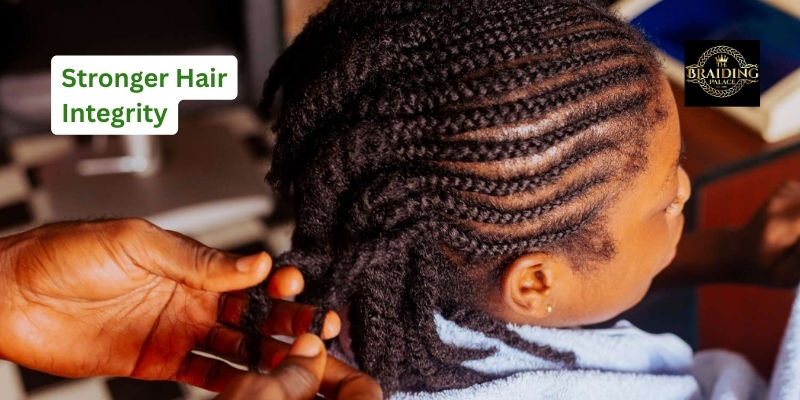Should You Braid Wet or Dry Hair? The Safer Option Explained
- The Braiding Palace
- May 6
- 4 min read
Updated: Nov 17

Braiding is more than appearance; it provides protective benefits for hair. It protects your hair while providing other functions. Whether wet or dry hair produces better braids remains a common question. Both choices have good points. Selecting the safer option between wet and dry hair braiding will extend the health of your hair for an extended period.
This article examines the positive and negative aspects of wet and dry hair braiding and offers expert recommendations regarding the safest braiding approach.
Is It Okay to Braid Hair While Wet?
People commonly braid their hair after washing it when it is still wet. They usually opt for braiding wet hair because it appears simpler and faster to complete. Hair becomes softer, making the stranding and twisting simpler when wet.
People braid wet hair because the appearance appeals to them, particularly when they want natural waves without using heated tools. The practice of braiding wet hair frequently results in consequences for the health of your hair. The improper care of wet hair can eventually result in damage or breakage.
Why Braiding Wet Hair Might Seem Ideal
Smoother Look

Handling wet hair is simpler than handling dry hair. When wet, the appearance of curly, coily, and frizzy hair types becomes smoother. The flat position of the hair strands creates a neat and defined appearance for braids.
Heatless Waves
Many people braid their wet hair before bed. The braids produce gentle waves that maintain a natural appearance when they get up in the morning. Braiding wet hair provides an easy method to style it without heat tools such as curling irons or straighteners.
Time-Saving
Washing your hair leaves you without enough time to dry it with a blow dryer. When performed while hair remains wet, the braiding process starts without drying the hair. Braiding your hair allows you to spend less time on your hairstyle so that you can continue your daily activities.
Why Braiding Wet Hair Can Be Risky
The process of braiding wet hair presents risks to your hair:
Wet Hair Is Weaker: When wet, hair absorbs water and extends in length. Braiding hair when wet makes the strands more susceptible to breaking, even though it may seem beneficial. The tight braiding of wet hair leads to snapping because wet hair remains more fragile than dry hair.
Hair Structure Can Be Damaged: Hair's natural bonds shift as it becomes wet. Braiding wet hair creates tiny fractures throughout the hair strands. Repeated damage from braiding wet hair eventually results in permanent harm.
More Breakage from Brushing and Pulling: Wet hair requires extra force for combing or parting. Braiding hair immediately after washing can produce additional breakage, particularly for people with fine or curly hair.
Smell and Scalp Problems: Braiding hair while wet maintains moisture inside the strands. When it fails to dry properly, the hair develops an unpleasant odor. This process resembles putting wet garments in a heap because they produce an unpleasant odor.
How Wet Braiding Affects Different Hair Types
Hair Type | Effect of Wet Braiding |
Thick/Coarse Hair | Stronger, but can still break over time if braided wet often. |
Fine/Thin Hair | Very likely to stretch, snap, and become damaged. |
Curly/Textured Hair | Very stretchy when wet, risking weaker curls and overall damage. |
What About Braiding Dry Hair? The Safer Choice
Most people should choose braiding dry hair because it offers better protection. Braiding dry hair provides protective benefits that improve hair health throughout the years.
Benefits of Braiding Dry Hair
Experts recommend braiding dry hair because it is a safer choice.
Stronger Hair Integrity

The natural state of dry hair makes it the most resilient. Your hair exists in a stable state, so it maintains its strength even when faced with additional stress without breaking. Dry hair becomes safer to style and braid due to its natural strength.
Reduced Breakage
Dry hair's stretching capability remains lower than that of wet hair. Because of this, dry hair experiences reduced tension during braiding. Braiding dry hair protects split ends and prevents strands from snapping or breaking.
More Volume
Dry braiding is an ideal method for increasing volume and texture in hairstyles. After the braids are removed, the hair will appear fuller and bouncier.
Downsides of Dry Braiding
Despite its benefits, there are disadvantages to dry braiding. Here are a few of them:
Flyaways and Frizz: Dry hair might develop frizziness and messiness. The hair shafts will protrude slightly from your braids. Apply a light cream or serum to your braids to smooth down the appearance while maintaining neatness.
Requires Preparation: Dry hair braiding requires necessary preparations. You should brush away all tangles before sectioning your hair correctly. The preparation process becomes crucial for people with thick or curly hair to achieve neat and uniform braids.
Best Practices for Healthy Braiding
Wet hair braiding should be done only occasionally, but you can minimize damage by using these steps.
Towel-Dry First: Dry the hair with a microfiber towel after blotting out excess water. Avoid braiding dripping wet hair.
Apply Leave-In Conditioner: The product minimizes friction and protects the cuticle.
Keep Braids Loose: The tension from tight braiding creates traction alopecia and other hairline problems.
Alternate Styling Methods: Daily wet braiding should be avoided as a regular practice. Your hair requires a specific amount of time to recover fully.
Conclusion
Dry hair braiding is a healthier way of keeping hair strands healthy. Wet braiding is a conditioning habit that creates potential damage that will become apparent in hair breakage over time. Dry braiding techniques offer better hair health, and proper care practices should be followed.
Now is the best time to style your hair with attractive protective braids. Contact The Braiding Palace for personalized braiding services that fit your hair requirements.








Comments